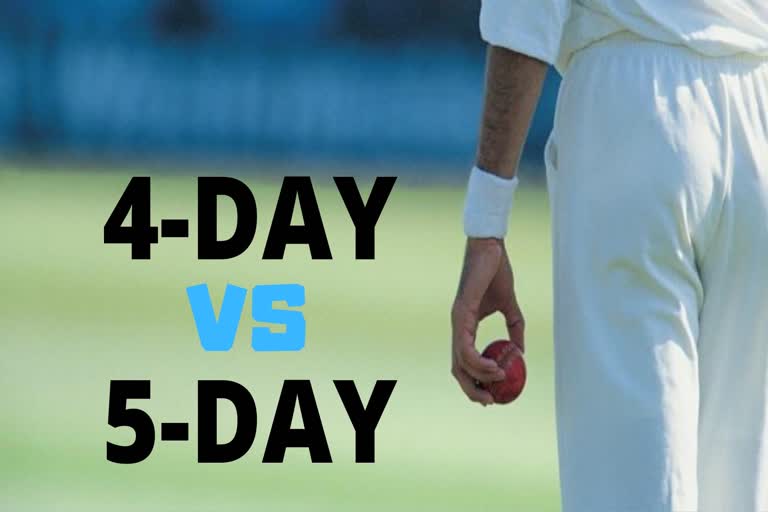Hyderabad: Test cricket was followed by ODI, ODI was followed by T20 after T20 came the T10 cricket which was followed by Pink Ball Test then came the 100 and now the latest addition in the list of cricket format is 4-Day Test.
The ICC cricket committee is likely to consider four-day Test matches as being part of the World Test Championship from 2023. ICC's increasing demand for event windows, the proliferation of domestic T20 leagues, BCCI's demands for its own sizable share of bilateral calendar space, and the costs of staging Test series are all said to be the factors contributing to the move.
Many former and current cricketers did not like the idea of the 4-Day Test. However, Australia, England and New Zealand cricket boards are positive about it.
So, let's have a look at some important aspects of the game.
What are the changes?
These are the rules from the first 4-Day international match played between South Africa and Zimbabwe in 2017.
Play will be scheduled for six-and-a-half hours each day, half an hour more than in five-day games, with 98 overs due to be bowled in a day, instead of 90.
As in five-day games, an extra half hour can be added in order to complete the overs.
The first two sessions of play will be two hours 15 minutes each, instead of two hours, with a 20-minute tea break instead of a lunch break after the first session.
There will be a 40-minute dinner break after the second session.
There is no provision for time lost to be carried over to subsequent days.
The follow-on can be enforced with a lead of 150 runs, compared to 200 runs in five-day games.
Play will start at 1.30 pm (1130 GMT) each day. The sunset in Port Elizabeth will be between 7.30 pm and 7.31 pm on the four days of the match, half an hour into the last session.
- Stats are behind 4-Day Test?All you need to know about '4-Day Test'
 All you need to know about '4-Day Test'
All you need to know about '4-Day Test'
First of all, it is important to know what are the reasons behind giving 4-Day Test a chance. Actually, talking about the records of the last two years, only 40% of the matches lasted till Day 5. In 2018-19, 60% of the matches within 4 days. Another stat in favour of the game is out of 39 Tests played in 2019, in only one match more than 400 overs were bowled. Only 13 of the 39 matches ended on the 5th day, of which 4 were drawn.
- Why do you want a 4-day Test match?All you need to know about '4-Day Test'
 All you need to know about '4-Day Test'
All you need to know about '4-Day Test'
It is being said that if all Test-playing nations accept playing 4-Day Test and if the matches are played according to the cricket cycle of 2015-23, then it will be a big benefit for the ICC and other boards and players. It is believed that a total of 335 days between 2023 and 2031 will be vacant due to the four-day test. These vacant days can be used for other Test series and tournaments, which can benefit the board, the ICC financially.
- More results?
It is also believed that if the test becomes four days, then the pitch curator will have to prepare such a pitch, which will decide the match in four days. This will make the Test match more exciting as there will be less draws. This will also speed up the game of Test matches.
- Rests for players?
Experts advocating for 4-Day Test matches also believe that if the Test is for four days, then the players will get more rest and their chances of getting injured will be less. For example, if a team plays 15 Tests in a year, then it is equal to 75 playing days. Meaning, having a 4-Day Test will reduce 15 days and if a test ends before four days, then that is a bonus.
- Big players say Big NoWhat does the big guns said?

The ICC is going to have a big meeting with other cricket boards on 4-Day Test matches. On the other hand, as soon as this news came out, many big players of the world have stood up against it. Australian players Nathan Lyon, Tim Paine, Glenn McGrath, Travis Head and Kiwi fast bowler Neil Wagoner have protested against this.
- Why not?
In 2019, out of all the Test matches which ended before 5 days, most of the strong teams had to face weak opposition. But if two strong opponents clash with each other, then the result of the match will not be possible in 4-Days. For example, if the recently concluded Ashes series were 4-Day Test, the England team would have won the Test series by 1-0. But as all three matches out of five went into 5th Day the series was drawn 2-2.
Talking about India's point of view skipper Virat Kohli, BCCI President Sourav Ganguly, Former India openers Gautam Gambhir and Sachin Tendulkar are not really positive about this. And as we know that BCCI has always been the last one to accept changes in cricket. So, it will be interesting to see if this idea can travel from the table to the ground.



